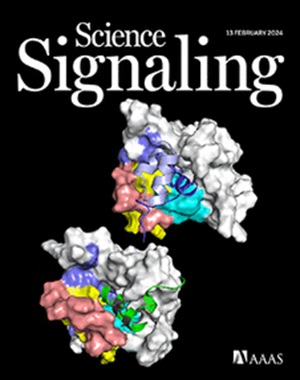对大肠杆菌中应激诱导的小蛋白的分析表明,YoaI介导不同信号系统之间的串扰
IF 6.6
1区 生物学
Q1 BIOCHEMISTRY & MOLECULAR BIOLOGY
引用次数: 0
摘要
细菌小蛋白(≤50个氨基酸)是一类新兴的调节因子,可调节信号网络的活性,使细菌适应压力。大肠杆菌基因组编码至少150种小蛋白质,其中大多数在功能上未被表征。通过核糖体分析、RNA测序和转录报告基因分析,我们鉴定并鉴定了大肠杆菌在镁(Mg2+)饥饿期间诱导的17个小蛋白。其中一些是由PhoQ-PhoP双组分信号系统转录激活的,这对Mg2+的稳态至关重要。在低mg2 +条件下,其中一些小蛋白的缺失或过表达导致生长缺陷和细胞大小的变化,表明在逆境适应中的生理作用。小跨膜蛋白YoaI在Mg2+限制下丰度增加,而不受YoaI转录或PhoQ-PhoP信号通路的影响。youai激活了第三个信号系统EnvZ-OmpR,该系统介导对渗透胁迫的反应。总的来说,本研究建立了一个初步框架,以了解小蛋白如何通过促进不同信号系统之间的串扰来促进细菌的应激适应。我们的研究结果表明,这些蛋白质在协调应激反应中发挥更广泛的作用,反映了细胞应激网络的相互联系性质,而不是对特定应激源作出反应的严格划分的途径。本文章由计算机程序翻译,如有差异,请以英文原文为准。
Analysis of stress-induced small proteins in Escherichia coli reveals that YoaI mediates cross-talk between distinct signaling systems
Bacterial small proteins (≤50 amino acids) are an emerging class of regulators that modulate the activity of signaling networks that enable bacterial adaptation to stress. The Escherichia coli genome encodes at least 150 small proteins, most of which are functionally uncharacterized. We identified and characterized 17 small proteins induced in E. coli during magnesium (Mg2+) starvation using ribosome profiling, RNA sequencing, and transcriptional reporter assays. Several of these were transcriptionally activated by the PhoQ-PhoP two-component signaling system, which is crucial for Mg2+ homeostasis. Deletion or overexpression of some of these small proteins led to growth defects and changes in cell size under low-Mg2+ conditions, indicating physiological roles in stress adaptation. The small transmembrane protein YoaI, which was transcriptionally induced by the phosphate-responsive PhoR-PhoB signaling pathway, increased in abundance under Mg2+ limitation independently of yoaI transcription or PhoQ-PhoP signaling. YoaI activated a third signaling system, EnvZ-OmpR, which mediates responses to osmotic stress. Overall, this study establishes an initial framework for understanding how small proteins contribute to bacterial stress adaptation by facilitating cross-talk between different signaling systems. Our results suggest that these proteins play broader roles in coordinating stress responses, reflecting the interconnected nature of cellular stress networks rather than strictly compartmentalized pathways responding to specific stressors.
求助全文
通过发布文献求助,成功后即可免费获取论文全文。
去求助
来源期刊

Science Signaling
BIOCHEMISTRY & MOLECULAR BIOLOGY-CELL BIOLOGY
CiteScore
9.50
自引率
0.00%
发文量
148
审稿时长
3-8 weeks
期刊介绍:
"Science Signaling" is a reputable, peer-reviewed journal dedicated to the exploration of cell communication mechanisms, offering a comprehensive view of the intricate processes that govern cellular regulation. This journal, published weekly online by the American Association for the Advancement of Science (AAAS), is a go-to resource for the latest research in cell signaling and its various facets.
The journal's scope encompasses a broad range of topics, including the study of signaling networks, synthetic biology, systems biology, and the application of these findings in drug discovery. It also delves into the computational and modeling aspects of regulatory pathways, providing insights into how cells communicate and respond to their environment.
In addition to publishing full-length articles that report on groundbreaking research, "Science Signaling" also features reviews that synthesize current knowledge in the field, focus articles that highlight specific areas of interest, and editor-written highlights that draw attention to particularly significant studies. This mix of content ensures that the journal serves as a valuable resource for both researchers and professionals looking to stay abreast of the latest advancements in cell communication science.
 求助内容:
求助内容: 应助结果提醒方式:
应助结果提醒方式:


